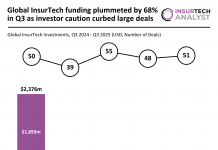In the world of insurance, the revolution spurred on by technology is not just reshaping the industry’s landscape, but also its impact on the planet. InsurTech companies are at the forefront of a sustainable revolution, steering the course toward a greener world. Through innovative practices and technological prowess, these firms are shaping a more responsible, environmentally conscious future, with impact investing at the heart of it.
Efrat Marmur, VP of Marketing at Air Doctor, underlined the pivotal juncture facing the InsurTech sector. The industry stands at the brink of transformation, increasingly prioritising sustainability, ESG principles, and risk mitigation.
In this dynamic landscape, prominent InsurTech firms must swiftly embrace evolution or risk becoming relics of a bygone era. This emphasis on adapting to contemporary trends has now become imperative to remain relevant in an industry that is shaking off its shackles of being stiff and rigid in reaction to progress.
Impact investing has swept through the sector, with the sector’s incumbents now looking at far loftier targets than just profits. Instead, the InsurTech space has now found itself at the forefront of change, leading forward a sustainable revolution that is even benefitting the consumer, as Marmur explained.
“InsurTech firms are developing innovative tools and technologies that help individuals and businesses assess, manage, and reduce their risks, thereby minimising the environmental impact of insurance claims. For instance, Air Doctor’s video consultation services help travellers identify and address health issues early on, preventing more serious and costly medical emergencies from occurring, as well as reducing the need for in-person medical visits and their associated carbon emissions.”
It’s as a result of this that customers are reaping the reward according to Marmur, who claimed that that this momentum is allowing them to gain; improved access to healthcare, become the recipient of superior risk management solutions, reduce insurance premiums, while also fostering a strong feeling of positivity, as they know they are supporting companies with good moral fibre.
Stan Skavronsky, a sales executive at Symfa, a custom software development company, concurred with the sentiment that the sector is now successfully pushing itself forward in the world of sustainability – and pointed out the efforts of the company Loop as a prime example.
He said, “A great example is Loop and their sustainable AI model for lower premiums. What Loop did was that they collected publicly available population size data on car crashes. By the year 2021, they had over 100m car crashes going back 15 years, operationalised across 27 states. Every police-reported crash gets its time and geolocation tag. The weather, the lane, the blind curve – all go towards the database to be later used for an accurate risk assessment. Thus, the startup hacks the loss experience.”
According to Skavronsky, Loop’s innovative approach allows them to offer impartial car coverage solely based on individual driving habits and preferred routes, eliminating the need for conventional metrics like credit scores, marital status, or job titles. He highlighted Loop’s commitment to ensuring equitable coverage for vulnerable communities residing farther from urban hubs.
These areas historically witness increased driving due to distance, making conventional pay-per-mile approaches impractical. Loop’s model acknowledges this higher car usage, aiming to provide fair and comprehensive coverage to prevent discriminatory practices based on location or driving habits.
Data analytics also sit firmly at the heart of this transformation towards impact investing. According to a report from Zurich Insurance Group, there is a rising necessity for insurers to gain precise insights into their customers and associated risks within a dynamic and intricate risk landscape.
In addition to this, Zurich emphasises the potential of data analytics to be able to offer solutions that help companies address some of their wider business needs, such as environmental social and governance (ESG) reporting or supporting their transition to net zero.
This means that with extra resources applied, technologies that have been at the core of InsurTech in recent years can be pushed toward impact investing and greener pastures.
Both of these points are very much in line with Marmur’s thinking, as she states, “InsurTech companies are using data analytics to identify patterns and trends that can help prevent insurance claims. For example, analysing telematics data can help identify driving habits that increase the risk of accidents, allowing for targeted interventions to improve safety and reduce environmental impact.”
This forward-thinking, preventative approach now seems to sit at the heart of the future of the InsurTech space – particularly when the need to be sustainable and ethical is now at the forefront of everyone’s mind.
Marmur continued, explaining that platforms like Air Doctor play a crucial role in connecting patients with healthcare providers virtually, effectively reducing the necessity for physical visits and consequently cutting down transportation-related emissions. Moreover, she stressed Air Doctor’s commitment to sustainability by actively supporting local healthcare resources.
This is achieved by directing patients to nearby doctors and specialists operating in local clinics and practices, eliminating the need for extensive travel to access quality medical care.
But how do traditional insurers compete in this challenging domain?
As insurers navigate the complexities of risk management in a rapidly changing environment, they face escalating pressure from various stakeholders—employees, investors, and regulators—to actively engage with the climate crisis. The imminent introduction of multiple regulations adds to this strain, compelling insurers to revamp their corporate disclosures.
Notably, within the EU, the Corporate Sustainability Reporting Directive (CSRD) mandates insurers to comprehensively report on their procedures for identifying and assessing adverse environmental and societal impacts. Additionally, insurers must spotlight the most significant sustainability risks that may ripple throughout their entire value chain.
This means that it is significant for insurers across the globe to make a swift and efficient adaptation to the demand to be more ESG-conscious.
Symfa’s Skavronsky delved into what many of the industry’s leading incumbents are doing to adapt. He said, “The incumbents came up with a great plan that works for everyone. A more characteristic trend of modern insurance is sustainable partnership, not direct competition.
“Say, INSTANDA and Farmsure. This partnership is a game-changer for insurance solutions in the agricultural sector combining INSTANDA’s no-code insurance technology with Farmsure’s agricultural risk management expertise. Climate change, regulatory shifts, and market uncertainties demand new insurance products that are more compatible with these challenges. This strategic partnership is expected to simplify product development of personalised and on-demand digital products for Farmsure,” he continued.
Skavronsky continued, explaining that this concept of a mutually beneficial partnership isn’t a recent phenomenon. Dating back to the early 2000s, established insurance firms have been offering startups support in the form of funding, data access, and involvement in various trials and proof-of-concepts.
Incubators like OnRamp, PlugandPlay, and InsurTech HuB Munich owe their existence partly to these incumbents. However, what’s less prevalent in 2023 is the surge in mergers and acquisitions, representing another traditional insurance response to the sustainable movement driven by InsurTech, citing the example of American Financial Group (AFG), which notably acquired Verikai, an AI and machine learning startup, in the initial months of 2022, he added.
Air Doctor’s Marmur gave her view on how the legacy incumbents are adapting to the switch in culture, stating, “Traditional insurers are expanding their product portfolios to include more sustainable options, such as green buildings insurance and carbon offset programs.”
However, this challenge of truly incorporating impact investing into an insurer’s business model is a multi-faceted task, according to Marmur.
Primarily, one of the major hurdles revolves around accurately measuring and reporting the tangible environmental and social impact of these investments. This necessitates the creation of robust and standardised metrics, which currently presents a complex task within the industry. Moreover, striking a delicate balance between financial objectives and sustainability commitments is crucial. InsurTech firms aiming to embrace impact investing must navigate the intricacies of aligning their financial goals with a genuine dedication to generating positive social and environmental outcomes, Marmur explained.
An eye to the future
The convergence of InsurTech and impact investing holds promising prospects for the future of the insurance industry. As technology continues to advance, InsurTech companies are expected to leverage innovative solutions to integrate impact investing more seamlessly into their operations.
There is a clear prospect to utilise advanced data analytics to bolster their environmental impact and placate potentially frustrated stakeholders. There is also potential for new conscious investors entering the market, who wish to join the journey to making the space more sustainable.
In the eyes of Air Doctor’s Marmur, “The demand for sustainable insurance products is expected to grow as individuals and businesses become increasingly aware of the environmental and social implications of their insurance choices.”
On top of this, “the synergy between the InsurTech sector and impact investing could stimulate further innovation and collaboration within the insurance industry, leading to the development of more sustainable and impactful solutions,” she said.
The convergence of InsurTech and impact investing heralds a promising era, where technological advancements and sustainable financial practices intertwine. This alignment presents an evolving landscape, one where tomorrow’s opportunities may not yet be visible today.
Both current and future incumbents in these domains find themselves navigating this transformative shift. As they steer toward a more sustainable future, the sector stands at the threshold of uncharted territory, where collaborative efforts, technological innovation, and a growing emphasis on social and environmental impact are set to redefine the insurance industry’s role in shaping a better world.
Copyright © 2023 InsurTech Analyst










